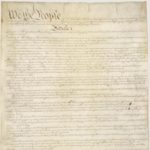Ten days after the Constitution was signed at the Old Philadelphia State House, an anonymous op-ed appeared in the New York Journal. Signed by “”Cato,” it cautioned readers of the new Constitution to take it with a grain of salt. Even the wisest of men, it warned, can make mistakes. This launched a public debate that would last months, pitting pro-Constitution Federalists against Constitution-wary Anti-Federalists. It was a battle for ratification, and it resulted in a glimpse into the minds of our Framers – and a concession that would come to define American identity.
Our guides through the minds of the Federalists and Anti-Federalists are Claire Griffin and Cheryl Cook-Kallio.
This short episode includes a one-page Graphic Organizer for students to take notes on while listening, as well as discussion questions on the back side.
Grade 6-8 Peter Prejudice’s Breeches: An Anti-Federalist Perspective
A complement to a lesson covering the Federalists and their influence over the Constitutional Convention, this lesson is intended to help students understand the Anti-Federalist perspective. By the conclusion of this lesson, students should be able to explain the differences between Federalists and Anti-Federalists. Students will be able to assess and sort both perspectives and identify the importance of Anti-Federalist views in shaping the Constitution as we know it.
Lesson 1: Anti-federalist Arguments Against “A Complete Consolidation”

This lesson focuses on the chief objections of the Anti-federalists, especially The Federal Farmer (Richard Henry Lee), Centinel, and Brutus, regarding the extended republic. Students will become familiar with the larger issues surrounding this debate, including the nature of the American Union, the difficulties of uniting such a vast territory with a diverse multitude of regional interests, and the challenges of maintaining a free republic as the American people moved toward becoming a nation.
Anti-Federalism and Dissent in Constitutional History
Saul Cornell, from Fordham University, and James Basker, the president of the Gilder Lehrman Institute, discuss anti-federalism and dissent in constitutional history. Anti-federalists were advocates against the ratification of the Constitution.
Federalist No. 10
Bill of Rights Overview
The Bill of Rights is the first 10 amendments to the U.S. Constitution. These amendments guarantee essential rights and civil liberties, such as the freedom of religion, the right to free speech, the right to bear arms, trial by jury, and more, as well as reserving rights to the people and the states. After the Constitutional Convention, the absence of a bill of rights emerged as a central part of the ratification debates. Anti-Federalists, who opposed ratification, pointed to the missing bill of rights as a fatal flaw. Several states ratified the Constitution on the condition that a bill of rights be promptly added. Pop over to the National Constitution Center’s learning module to discover more!
Ratifying the Constitution

This lesson introduces students to the vigorous debates between the Federalist and the Anti-Federalists surrounding the ratification of the Constitution that took place in the state conventions.
In the state ratification conventions, delegates argued the wisdom of adopting the Constitution. Elected specifically to serve in these conventions, they came from a range of backgrounds, from the very elite and highly educated, to those of humbler birth and station. State delegates grappled with questions about the nature of democracy, the distribution of wealth and power in society, the rights of individuals and minority groups, and the role of dissent in a republic.
Commemorating Constitution Day
EDSITEment’s guide for teachers includes lesson plans for K-12 civics education that include analyzing art and primary sources, compelling questions, web-based interactives, and Spanish language resources.
Popular Sovereignty and Constitutional Ratification

This short video highlights the importance of popular sovereignty in the ratification debates. The people themselves, through their elected delegates in specially-called conventions, voted up or down on the new Constitution. Professor John Kaminksi notes how the Antifederalists also used the principle of popular sovereignty to justify their call for constitutional amendments.
Article VII: Ratification
After months of debate during the hot Philadelphia summer, on September 17, 1787, the Constitutional Convention finally adjourned and the new Constitution was signed, but it was not the law of the land yet. According to Article VII of the document, nine of 13 states would have to ratify (or approve) the new Constitution before it would officially replace the Articles of Confederation as our governing document.
